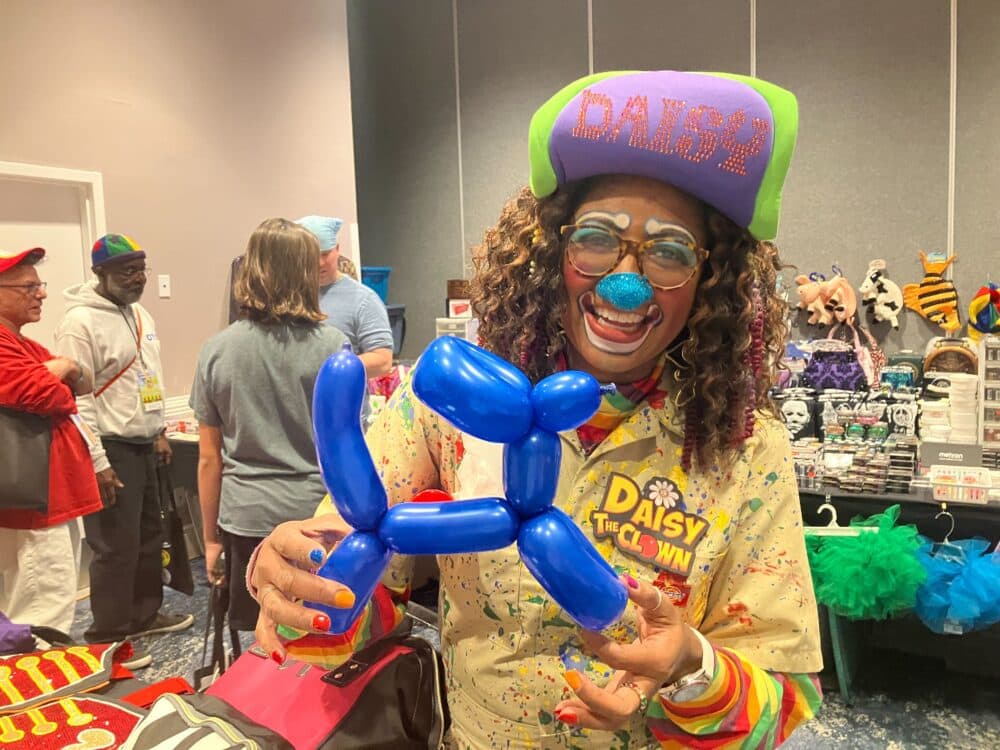Advertisement
Clowns are back after taking a hit during the pandemic. But changes to the industry linger

Though attendees walk the halls in makeup and really big shoes with propellers on them, the World Clown Association convention in Orlando, Florida isn’t much different than most conventions. Conference sessions teaching industry tricks and vendors selling gadgets — think rubber chickens and jumbo scissors — line the showroom floor.
Like other performers during the pandemic, clowns had to either hunker down or pivot to survive. And now that birthday parties and corporate events are back, so are the clowns.
Debra Miller has been a clown for 42 years and owns a supply company selling merchandise at the convention. Her table is stacked with makeup, hats, rainbow colored suspenders, tutus and big, floppy guns. The pandemic affected not just her business, but also her work as a clown.
“We went from having almost 400 shows maybe down to 20, and those were private parties where people weren’t afraid,” says Miller.
As pandemic restrictions first lifted, she noticed that kids were skittish and afraid to hug. Now, they’re happy again.
“People need fun, more,” Miler says. “People just need some happiness, some joy, and clowns bring that out.”
Kynisha Ducre, or Daisy the Clown, specializes in making balloon animals. One small way the pandemic changed clowning for her is the tiny, red pump she pulls out of her bag to blow up a long, blue balloon that she twists into a dog.
“In the pandemic, that’s salvia that will be on the balloon, so you really don’t want to blow them up,” Ducre says.
Ducre performs for just about everyone, from children to sports teams to tech workers. She adapted during the pandemic by moving her shows to YouTube and performed outside the windows of nursing homes.
She’s been a clown for 20 years, and says the pandemic’s impact on clowning was temporary.
But pop culture is the force that has made permanent changes to her industry.
Scary movies like “It” — featuring the terrifying clown Pennywise, who lives in the sewers — have made kids so scared of clowns that she’s changed how she approaches them.
Advertisement
“You don’t go to the kids quite as close, you have to not make any sudden movements,” says Ducre.
It’s also changed how much clowns cover up their body.
Jackie Newton, aka Sparky Malarkey, says more clowns make sure kids know there’s a person underneath. They’ve ditched the gloves and wear less makeup.
“We’re more lightfaced, you can kind of see our face,” says Newton.
She laughs it off when asked about how Pennywise represents clowns in popular culture.
“Well, this is a newer generation so they love that kind of thing, so I don’t diss it,” Newton says. “But I do tease that Stephen King has made our job a little tough.”
The clowns at this convention know all too well that some people are genuinely creeped out by clowns.
Karl Krohne, or Dreamboat The Clown, dresses like a traditional circus clown with a completely white face, red nose, bright suit and big shoes. He often hears about people’s fear of clowns.
“Almost every person who has told me they’re scared of clowns, when I tell them what I do, has actually never actually met a clown,” says Krohne.
So if you’re afraid of clowns, he suggests that you go meet one.
Catherine Welch produced and edited this interview for broadcast with Eileen Bolinsky. Welch also adapted it for the web.
This segment aired on March 23, 2023.
